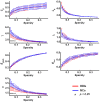Disrupted topological organization in whole-brain functional networks of heroin-dependent individuals: a resting-state FMRI study
- PMID: 24358220
- PMCID: PMC3866189
- DOI: 10.1371/journal.pone.0082715
Disrupted topological organization in whole-brain functional networks of heroin-dependent individuals: a resting-state FMRI study
Abstract
Neuroimaging studies have shown that heroin addiction is related to abnormalities in widespread local regions and in the functional connectivity of the brain. However, little is known about whether heroin addiction changes the topological organization of whole-brain functional networks. Seventeen heroin-dependent individuals (HDIs) and 15 age-, gender-matched normal controls (NCs) were enrolled, and the resting-state functional magnetic resonance images (RS-fMRI) were acquired from these subjects. We constructed the brain functional networks of HDIs and NCs, and compared the between-group differences in network topological properties using graph theory method. We found that the HDIs showed decreases in the normalized clustering coefficient and in small-worldness compared to the NCs. Furthermore, the HDIs exhibited significantly decreased nodal centralities primarily in regions of cognitive control network, including the bilateral middle cingulate gyrus, left middle frontal gyrus, and right precuneus, but significantly increased nodal centralities primarily in the left hippocampus. The between-group differences in nodal centralities were not corrected by multiple comparisons suggesting these should be considered as an exploratory analysis. Moreover, nodal centralities in the left hippocampus were positively correlated with the duration of heroin addiction. Overall, our results indicated that disruptions occur in the whole-brain functional networks of HDIs, findings which may be helpful in further understanding the mechanisms underlying heroin addiction.
Conflict of interest statement
Figures

 , clustering coefficient;
, clustering coefficient;  , characteristic path length;
, characteristic path length;  , normalized clustering coefficient;
, normalized clustering coefficient;  , normalized shortest path length;
, normalized shortest path length;  , small-worldness;
, small-worldness;  , global efficiency;
, global efficiency;  , local efficiency.
, local efficiency.
 (p = 0.049) and integrated small-worldness
(p = 0.049) and integrated small-worldness  (p = 0.035).
(p = 0.035).  , integrated clustering coefficient;
, integrated clustering coefficient;  , integrated characteristic path length;
, integrated characteristic path length;  , integrated normalized shortest path length;
, integrated normalized shortest path length;  , integrated global efficiency;
, integrated global efficiency;  , integrated local efficiency.
, integrated local efficiency.

 , against the mean functional connectivity of this connected subnetwork averaged over all subjects. (c) Same as (b) but for the integrated normalized clustering coefficient,
, against the mean functional connectivity of this connected subnetwork averaged over all subjects. (c) Same as (b) but for the integrated normalized clustering coefficient,  . (d) Same as (b) but for integrated small-worldness,
. (d) Same as (b) but for integrated small-worldness,  . The abbreviations of the regions are listed in Table S2.
. The abbreviations of the regions are listed in Table S2.Similar articles
-
Abnormal white matter structural networks characterize heroin-dependent individuals: a network analysis.Addict Biol. 2016 May;21(3):667-78. doi: 10.1111/adb.12234. Epub 2015 Mar 4. Addict Biol. 2016. PMID: 25740690
-
Aberrant default-mode functional and structural connectivity in heroin-dependent individuals.PLoS One. 2015 Apr 10;10(4):e0120861. doi: 10.1371/journal.pone.0120861. eCollection 2015. PLoS One. 2015. PMID: 25859661 Free PMC article.
-
Altered small-world brain functional networks and duration of heroin use in male abstinent heroin-dependent individuals.Neurosci Lett. 2010 Jun 14;477(1):37-42. doi: 10.1016/j.neulet.2010.04.032. Epub 2010 Apr 22. Neurosci Lett. 2010. PMID: 20417253
-
Imaging Diagnosis of Central Nervous System Damage in Patients with T2DM.Neurosci Lett. 2020 Aug 10;733:135092. doi: 10.1016/j.neulet.2020.135092. Epub 2020 May 23. Neurosci Lett. 2020. PMID: 32454146 Review.
-
Resting-state Abnormalities in Heroin-dependent Individuals.Neuroscience. 2018 May 15;378:113-145. doi: 10.1016/j.neuroscience.2016.11.018. Epub 2016 Nov 21. Neuroscience. 2018. PMID: 27884551 Review.
Cited by
-
A hyper-connected but less efficient small-world network in the substance-dependent brain.Drug Alcohol Depend. 2015 Jul 1;152:102-8. doi: 10.1016/j.drugalcdep.2015.04.015. Epub 2015 May 1. Drug Alcohol Depend. 2015. PMID: 25957794 Free PMC article.
-
Disrupted resting-state brain functional network in methamphetamine abusers: A brain source space study by EEG.PLoS One. 2019 Dec 11;14(12):e0226249. doi: 10.1371/journal.pone.0226249. eCollection 2019. PLoS One. 2019. PMID: 31825996 Free PMC article.
-
Prediction of Biological Motion Perception Performance from Intrinsic Brain Network Regional Efficiency.Front Hum Neurosci. 2016 Nov 2;10:552. doi: 10.3389/fnhum.2016.00552. eCollection 2016. Front Hum Neurosci. 2016. PMID: 27853427 Free PMC article.
-
Computer-aided classifying and characterizing of methamphetamine use disorder using resting-state EEG.Cogn Neurodyn. 2019 Dec;13(6):519-530. doi: 10.1007/s11571-019-09550-z. Epub 2019 Aug 7. Cogn Neurodyn. 2019. PMID: 31741689 Free PMC article.
-
Analysis of Resting-State fMRI Topological Graph Theory Properties in Methamphetamine Drug Users Applying Box-Counting Fractal Dimension.Basic Clin Neurosci. 2017 Sep-Oct;8(5):371-385. doi: 10.18869/nirp.bcn.8.5.371. Basic Clin Neurosci. 2017. PMID: 29167724 Free PMC article.
References
-
- Volkow ND, Li TK (2004) Drug addiction: the neurobiology of behaviour gone awry. Nat Rev Neurosci 5: 963–970. - PubMed
-
- Tang YL, Zhao D, Zhao C, Cubells JF (2006) Opiate addiction in China: current situation and treatments. Addiction 101: 657–665. - PubMed
-
- Dackis CA, Gold MS (1985) New concepts in cocaine addiction: the dopamine depletion hypothesis. Neurosci Biobehav Rev 9: 469–477. - PubMed
-
- Lee TM, Zhou WH, Luo XJ, Yuen KS, Ruan XZ, et al. (2005) Neural activity associated with cognitive regulation in heroin users: a fMRI study. Neurosci Lett 382: 211–216. - PubMed
Publication types
MeSH terms
LinkOut - more resources
Full Text Sources
Other Literature Sources
Medical

